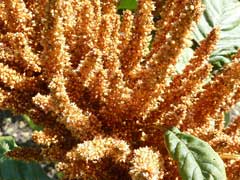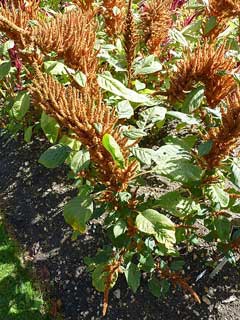 |
|
commons.wikimedia.org/wiki/User:Magnus_Manske |
 |
| commons.wikimedia.org/wiki/User:Magnus_Manske |
Translate this page:
Summary
Physical Characteristics

 Amaranthus hypochondriacus is a ANNUAL/PERENNIAL growing to 1.2 m (4ft) by 0.5 m (1ft 8in).
Amaranthus hypochondriacus is a ANNUAL/PERENNIAL growing to 1.2 m (4ft) by 0.5 m (1ft 8in).
See above for USDA hardiness. It is hardy to UK zone 4 and is frost tender. It is in leaf from April to October, in flower from July to August, and the seeds ripen from August to September. The species is monoecious (individual flowers are either male or female, but both sexes can be found on the same plant) and is pollinated by Wind. The plant is self-fertile.
Suitable for: light (sandy), medium (loamy) and heavy (clay) soils and prefers well-drained soil. Suitable pH: mildly acid, neutral and basic (mildly alkaline) soils. It cannot grow in the shade. It prefers moist soil.
UK Hardiness Map
US Hardiness Map
Synonyms
A. hybridus hypochondriachus. (L.)Thell.
Plant Habitats
Cultivated Beds;
Edible Uses
Edible Parts: Leaves Seed
Edible Uses: Colouring
Young leaves - cooked as a spinach[183, 238]. Rich in vitamins and minerals, they have a mild flavour[K]. Seed - raw or cooked. They can be used as a cereal substitute. They can also be popped in much the same way as popcorn[183]. The seed can be soaked for 12 hours in warm water and then allowed to sprout for about 11 days[244]. They can then be added to salads[183]. Very small but the seed is easy to harvest and very nutritious. The seed can be cooked whole, and becomes very gelatinous like this, but it is rather difficult to crush all of the small seeds in the mouth and thus some of the seed will pass right through the digestive system without being assimilated[K]. A red pigment obtained from the plant is used as a food colouring[238].
References More on Edible Uses
Medicinal Uses
Plants For A Future can not take any responsibility for any adverse effects from the use of plants. Always seek advice from a professional before using a plant medicinally.
Antidiarrhoeal Astringent
The whole plant contains tannin and is astringent[238, 254]. It is used internally in the treatment of diarrhoea and excessive menstruation[238, 254]. It can be used as a gargle to soothe inflammation of the pharynx and to hasten the healing of ulcerated mouths[254], whilst it can also be applied externally to treat vaginal discharges, nosebleeds and wounds[238]. The plant can be used fresh or it can also be harvested when coming into flower and dried for later use[238].
References More on Medicinal Uses
The Bookshop: Edible Plant Books
Our Latest books on Perennial Plants For Food Forests and Permaculture Gardens in paperback or digital formats.

Edible Tropical Plants
Food Forest Plants for Hotter Conditions: 250+ Plants For Tropical Food Forests & Permaculture Gardens.
More

Edible Temperate Plants
Plants for Your Food Forest: 500 Plants for Temperate Food Forests & Permaculture Gardens.
More

More Books
PFAF have eight books available in paperback and digital formats. Browse the shop for more information.
Shop Now
Other Uses
Dye
Yellow and green dyes can be obtained from the whole plant[168]. A red dye obtained from the plant (the report does not specify which part of the plant) is used as a colouring in foods and medicines[238].
Special Uses
Dynamic accumulator Food Forest
References More on Other Uses
Cultivation details
Prefers a well-drained fertile soil in a sunny position[200]. Requires a hot sheltered position if it is to do well[K]. Tolerates a pH in the range 5.2 to 7.5. Plants should not be given inorganic fertilizers, see notes above on toxicity. Often cultivated, especially in tropical areas, for its edible leaves and seeds, there are many named varieties[183]. This is the most robust and highest yielding of the grain amaranths, though it is late maturing and therefore less suitable for northern areas[183]. Most if not all members of this genus photosynthesize by a more efficient method than most plants. Called the 'C4 carbon-fixation pathway', this process is particularly efficient at high temperatures, in bright sunlight and under dry conditions[196]. In garden design, as well as the above-ground architecture of a plant, root structure considerations help in choosing plants that work together for their optimal soil requirements including nutrients and water. The root pattern is clumping, giving the plant a clumping habit. The predictable growth behaviour makes it easier to maintain without having to apply containment methods[2-1].
References Carbon Farming Information and Carbon Sequestration Information
Temperature Converter
Type a value in the Celsius field to convert the value to Fahrenheit:
Fahrenheit:
The PFAF Bookshop
Plants For A Future have a number of books available in paperback and digital form. Book titles include Edible Plants, Edible Perennials, Edible Trees,Edible Shrubs, Woodland Gardening, and Temperate Food Forest Plants. Our new book is Food Forest Plants For Hotter Conditions (Tropical and Sub-Tropical).
Shop Now
Plant Propagation
Seed - sow late spring in situ. An earlier sowing can be made in a greenhouse and the plants put out after the last expected frosts. Germination is usually rapid and good if the soil is warm[133]. A drop in temperature overnight aids germination[133]. Cuttings of growing plants root easily[206].
Other Names
If available other names are mentioned here
Native Range
NORTHERN AMERICA: Kansas, Mexico Central, Mexico Gulf, Mexico Northeast, Mexico Northwest, Mexico Southwest, Minnesota, Missouri, Nebraska, Texas, Wisconsin,
Weed Potential
Right plant wrong place. We are currently updating this section.
Please note that a plant may be invasive in one area but may not in your area so it's worth checking.
Conservation Status
IUCN Red List of Threatened Plants Status :

| Related Plants
|
| Latin Name | Common Name | Habit | Height | Hardiness | Growth | Soil | Shade | Moisture | Edible | Medicinal | Other |
| Amaranthus acanthochiton | Greenstripe Amaranth | Annual | 0.5 |
7-10
| F | LM | N | DM | 2 | 0 | 0 |
| Amaranthus albus | Prostrate Pigweed | Annual | 0.7 |
4-10
| | LMH | N | M | 4 | 0 | 1 |
| Amaranthus bidentata | | Annual | 0.9 |
-
| | LMH | N | M | 2 | 1 | 1 |
| Amaranthus blitoides | Mat Amaranth | Annual | 0.2 |
4-10
| | LMH | N | M | 3 | 0 | 1 |
| Amaranthus blitum | Slender Amaranth, Purple amaranth | Annual | 1.0 |
4-8
| | LMH | N | M | 4 | 2 | 2 |
| Amaranthus campestris | | Annual | 0.0 |
-
| | LMH | N | M | 2 | 1 | 1 |
| Amaranthus caudatus | Love Lies Bleeding | Annual | 2.0 |
4-8
| | LMH | N | DM | 4 | 1 | 2 |
| Amaranthus cruentus | Purple Amaranth, Red amaranth | Annual | 2.0 |
4-10
| | LMH | N | M | 5 | 2 | 2 |
| Amaranthus diacanthus | | Annual | 0.0 |
-
| | LMH | N | M | 2 | 0 | 1 |
| Amaranthus dubius | Spleen Amaranth | Annual | 1.0 |
-
| | LMH | N | M | 2 | 0 | 1 |
| Amaranthus fimbriatus | Fringed Amaranth | Annual | 0.6 |
5-10
| F | LM | N | DM | 5 | 0 | 0 |
| Amaranthus frumentaceus | | Annual | 0.0 |
-
| | LMH | N | M | 2 | 0 | 1 |
| Amaranthus graecizans | Spreading Pigweed, Mediterranean amaranth | Annual | 0.5 |
0-0
| | LMH | N | M | 2 | 0 | 1 |
| Amaranthus hybridus | Rough Pigweed, Slim amaranth | Annual | 2.0 |
5-12
| | LMH | N | M | 5 | 1 | 1 |
| Amaranthus mangostanus | | Annual | 1.5 |
-
| | LMH | N | M | 2 | 0 | 1 |
| Amaranthus mitchellii | Boggabri Weed | Annual | 0.5 |
-
| | LMH | N | M | 2 | 0 | 1 |
| Amaranthus pallidiflorus | | Annual | 1.0 |
-
| | LMH | N | M | 2 | 0 | 1 |
| Amaranthus palmeri | Careless Weed | Annual | 0.9 |
6-12
| F | LMH | N | M | 5 | 0 | 1 |
| Amaranthus polygamus | | Annual | 0.0 |
-
| | LMH | N | M | 2 | 1 | 1 |
| Amaranthus polystachyus | | Annual | 0.0 |
-
| | LMH | N | M | 2 | 0 | 1 |
| Amaranthus powellii | Powell's Amaranth | Annual | 1.5 |
5-11
| F | LMH | N | M | 5 | 0 | 1 |
| Amaranthus quitensis | Ataco | Annual | 1.0 |
-
| | LMH | N | M | 2 | 0 | 1 |
| Amaranthus retroflexus | Pigweed, Redroot amaranth, Wild Beet | Annual | 0.9 |
5-11
| | LMH | N | M | 5 | 2 | 2 |
| Amaranthus spinosus | Spiny Amaranth | Annual | 0.6 |
4-11
| | LMH | N | M | 2 | 3 | 1 |
| Amaranthus standleyanus | Indehiscent Pigweed | Annual | 0.7 |
-
| | LMH | N | M | 2 | 0 | 1 |
| Amaranthus tenuifolius | | Annual | 0.0 |
-
| | LMH | N | M | 2 | 0 | 1 |
| Amaranthus thunbergii | Thunberg's Pigweed, Thunberg's amaranthus | Annual | 0.5 |
0-0
| | LMH | N | M | 2 | 0 | 1 |
| Amaranthus torreyi | Torrey's amaranthus | Annual | 0.8 |
6-10
| F | LMH | N | M | 4 | 0 | 1 |
| Amaranthus tricolor | Chinese Spinach, Joseph's-coat, Fountain Plant, Tampala , Summer Poinsettia | Annual | 1.0 |
3-11
| M | LMH | N | M | 3 | 1 | 2 |
|
|
Growth: S = slow M = medium F = fast. Soil: L = light (sandy) M = medium H = heavy (clay). pH: A = acid N = neutral B = basic (alkaline). Shade: F = full shade S = semi-shade N = no shade. Moisture: D = dry M = Moist We = wet Wa = water.
Now available:
Food Forest Plants for Mediterranean Conditions
350+ Perennial Plants For Mediterranean and Drier Food Forests and Permaculture Gardens.
[Paperback and eBook]
This is the third in Plants For A Future's series of plant guides for food forests tailored to
specific climate zones. Following volumes on temperate and tropical ecosystems, this book focuses
on species suited to Mediterranean conditions—regions with hot, dry summers and cool, wet winters,
often facing the added challenge of climate change.
Read More
Expert comment
Author
L.
Botanical References
200266
Links / References
For a list of references used on this page please go here
Readers comment